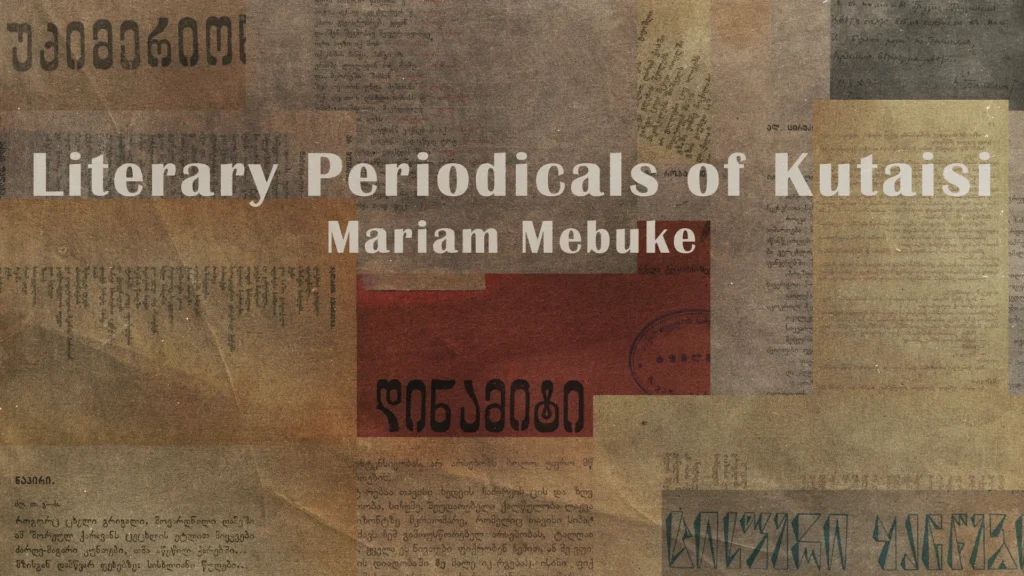Kultura! – Article Archive
Rosa Tavdidishvili – “Sidonia the Educator” of Kutaisi’s Jewish Quarter
For a Jewish woman raised in a traditional family, walking from street to street, from family to family, or from one congregation to another in the 1930s and 1940s, pencil and notebook in hand, must have been incredibly challenging. Rosa Khananashvili was that determined and enthusiastic woman who broke barriers to take the first step in ethnographic research about the lives of Georgian (Kutaisi) Jews. Her remarkable talent and abilities helped her achieve the seemingly impossible: creating a unique work titled Ethnographic Essay on the Ancient Life of the Jews of Kutaisi.
“Rezo Gabriadze’s ‘White Bridge’ and Urban Literature”
Cities in fiction reflect a range of associations, capturing the personal, cultural, and historical dimensions that define each era. Just as Maupassant’s Paris in the 19th century requires context to fully understand the significance of a woman smiling from her balcony, so does Rezo Gabriadze’s 20th-century Kutaisi. In his story “White Bridge,” Gabriadze illuminates the unique, often humorous, character of his hometown, blending its historical, social, and emotional contours into a tale that embodies the warmth and complexities of Kutaisi life.
Peasant Uprisings of Imereti and Samegrelo in the 19th Century
Georgian cultural history contains countless stories—some told openly, others whispered; some recorded, others left incomplete. Many of these stories find their legitimacy in words, sentences, and written records. But what happens to those stories that remain hidden, denied the honor of remembrance? Despite their intrinsic value and the suffering of those involved, these narratives often fade into obscurity, buried in the repressed corners of collective memory.
Kutaisi’s Literary Salons
In an era when Georgia lacked theaters, magazines, newspapers, and formal cultural institutions, literary gatherings held within private homes nurtured and advanced the nation’s intellectual and cultural life. Across Europe and Russia, family salons became cultural staples, serving as crucibles for ideas and artistic exchange.
“Do you serve the nation?” – “Forever!” (Niko Nikoladze’s descendants)
Sometimes, the children of great people remain unnoticed by society and history, as if they cannot escape their parent’s shadow. In this case, the opposite happened. The lives and achievements of Niko Nikoladze’s descendants became a continuation of his immeasurable contribution. The work of Niko’s son, Giorgi Nikoladze, is no less significant than his father’s.
Literary Periodicals of Kutaisi
The creative legacy of Kutaisi in Georgian literature finds its roots with the first Georgian Symbolist poets and prose writers, who established a creative association and produced the magazine Tsisperi Kancebi (Blue Horns) in 1916, with only two issues published. This effort marked the beginning of a vibrant, if at times short-lived, period of literary expression, with various magazines and newspapers emerging over the years to document and influence the literary movements and creative energies of the time.
Luka Asatiani, Mitrofan Lagidze, and Others
A journey to old Kutaisi begins somewhere at the intersection of the French and Jewish Quarters or, at the very least, when you step onto the cobblestones of Gelati Street. However, this journey can also start with the “Passages”—as the local residents of Kutaisi still refer to the commercial rows stretching from the central square to the Greenmarket. Most people may not even know that the name is tied to entrepreneur Jakob Begishvili, who lived in the city during the latter half of the 19th century.
A Small Anthropological Analysis of Urban Space: The Example of Kutaisi
The social and cultural construction of urban space remains a significant and timely subject within urban studies, particularly in the fields of social and cultural anthropology. Ethnographic research, especially that gathered through participant observation, deepens our understanding of this expansive topic. Recent advances in urban studies explore the continuous interaction between people, the city, and its architectural elements—such as squares, parks, stations, and bus stops—creating a distinctive social climate, marked by unique patterns of behavior and communication.
Graffiti – A Modern Form of Storytelling in Kutaisi
“I had to leave something for you before I returned to my refuge, where there is not even a mirror, only a hole, where until the final complete darkness I can hide, remember so many things, and imagine from time to time how you continue to paint again, how you leave the house at night to paint again.”
— Julio Cortázar, Graffiti. Have you ever considered how things that are part of our daily lives gradually become invisible over time? This observation applies to the architecture and character of the city we live in. The places we frequent fade into the background as if we believe they are immutable, forever locked in our memories.
Spreading Music in Kutaisi
The experience of music is a profound joy, and for many music lovers, it’s not just about listening to recordings or attending concerts—it’s about owning them. People are naturally possessive; they want to hold and touch what they love. That’s why so many music enthusiasts collect music. Until the early 21st century, owning music meant accumulating physical media—vinyl records, cassette tapes, or compact discs. Music had a tangible form that could be placed on a table, a shelf, or even carried in a pocket.











